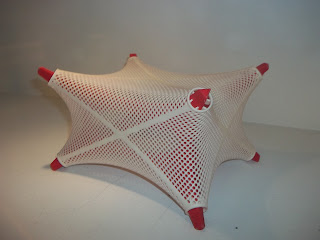Today’s guest blog is from Wilson Peterson of Wedge Studio; Wilson is a practicing architect and teaches at the University of Arizona School of Architecture
Lithocubus is a seating device that was produced for the Acadia 2011design + fabrication competition, where it placed as a finalist in the furniture category. Lithocubus takes its inspiration and its name from the Radiolarians, a variety of plankton described by Ernst Haeckel, a zoologist from the University of Jena. In the 1860s and 70s Haeckel made scientific expeditions in the Mediterranean and to the Canary Islands during which he made precise drawings of the organisms he observed under his microscope.
Radiolarians are unicellular, but are divided into a membrane containing endoplasm and outer membranes containing ectoplasm. They have skeletons made of silica, that form by accretion between the bubble-like vesicles of ectoplasm surrounding the organism. In his book, On Growth and Form, D’Arcy Thompson described the minimal surface geometry apparent in the Radiolarians.
The structure of Lithocubus follows that of radiolarians. The aluminum frame of Lithocubus is defined by the interstices between adjacent bubbles. The resulting arched forms are rigid in compression. Affixed to this skeleton is an outer fabric membrane. The organization into a compressive frame and a tensile membrane follows the logic of large-scale tensile fabric structures. The membrane is a mesh fabric with an open weave, relatively transparent, to allow the internal frame to be seen.
As a seating device, Lithocubus can be placed on any of its six sides, affording three seating heights. The aluminum frame protrudes through the fabric to elevate it off the ground. The fabric supporting the body is held by tension rings at the corners and does not contact the frame. All faces of the aluminum frame are developable approximations of the synclastically curved forms derived from the minimal surface geometry of the bubbles. The fabric surface, a complexly-curved, tensile membrane, has a more fluid geometry.
Making a 3D print of the design presented a challenge: the design proposed a transparent fabric stretched over a rigid frame. If the fabric were printed as a surface, it would completely obscure the frame. I modeled the fabric as an open weave using Rhino Paneling tools. The model was printed on a ZPrinter 650 from Z Corporation. This allowed the frame and skin to be printed in contrasting colors all at once (no assembly), so the frame is visible through the skin. This was a much clearer expression of the design intent than would be possible with a monochrome print.
http://www.zcorp.com/en/Solutions/Architecture/spage.aspx
skip to main |
skip to sidebar
Subscribe to:
Post Comments (Atom)










Tridaxis Review
ReplyDeletehttp://tridaxis.wordpress.com
Thank you! That's great!!
ReplyDeleteIs a pleasure to spread the word Z Corporation.
ReplyDelete
ReplyDeleteWooden Loft Bed QWith Des
Wooden Loft Bed With Desk is different from a normal bunk bed used in children bedroom. In a normal bunk be two single beds are arranged one over the other to form a two levels of sleeping arrangement so that the floor space which otherwise would have occupied by one single bed is reveled for some other use such as a study table or a small storage for the kids toys, books or any other things.
Thanks so much for linking up to Catch as Catch Can--your link was the favorite from last week's party! office furniture
ReplyDeleteThat looks beautiful!! I love the bold color you chose and how the gold hardware really pops against it.
ReplyDeleteBobs Discount Furniture
In any case, if the expression "present day" is connected with unadulterated white furniture on brilliant red or blue covering, or splendidly shaded pieces sitting on pale-hued floors, furniture makers london
ReplyDeleteThanks......
ReplyDelete3d prototyping
wonderful post which was informative
ReplyDelete3d printing service
3d printer filament bangalore
3D Prototype Printing Services
nice blog post
ReplyDelete3d printed products
3d prototyping
3d printer filament